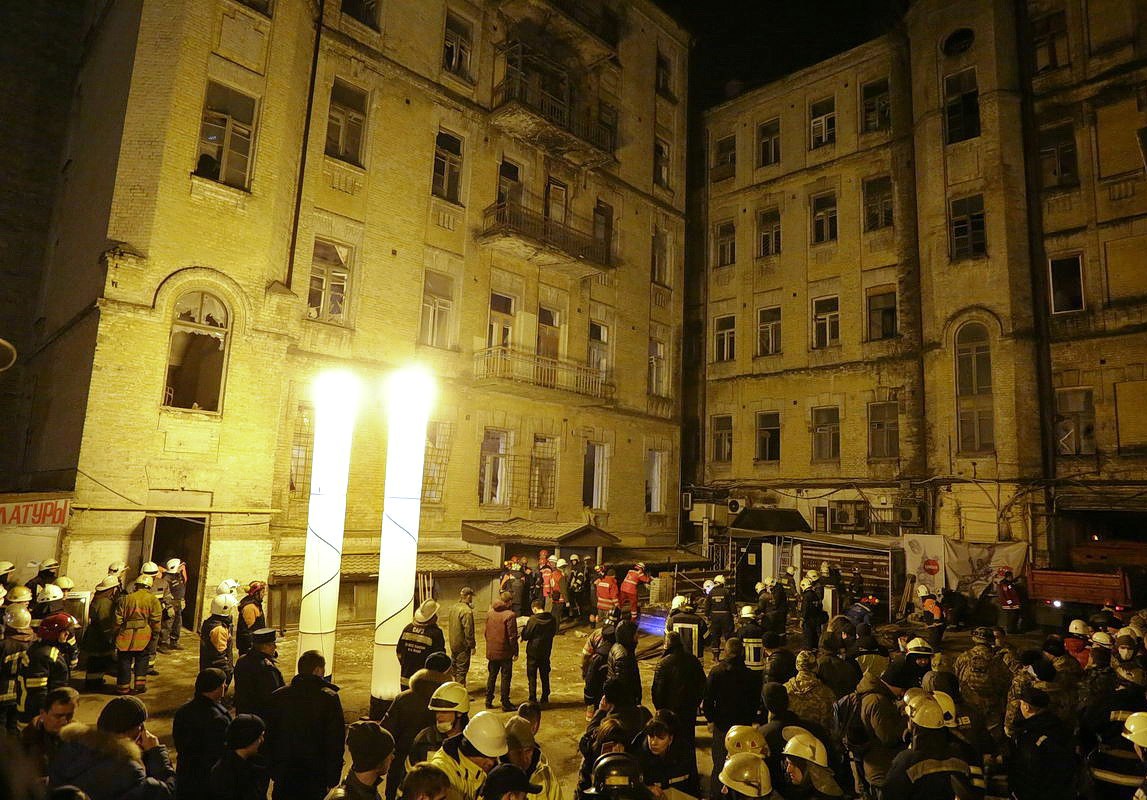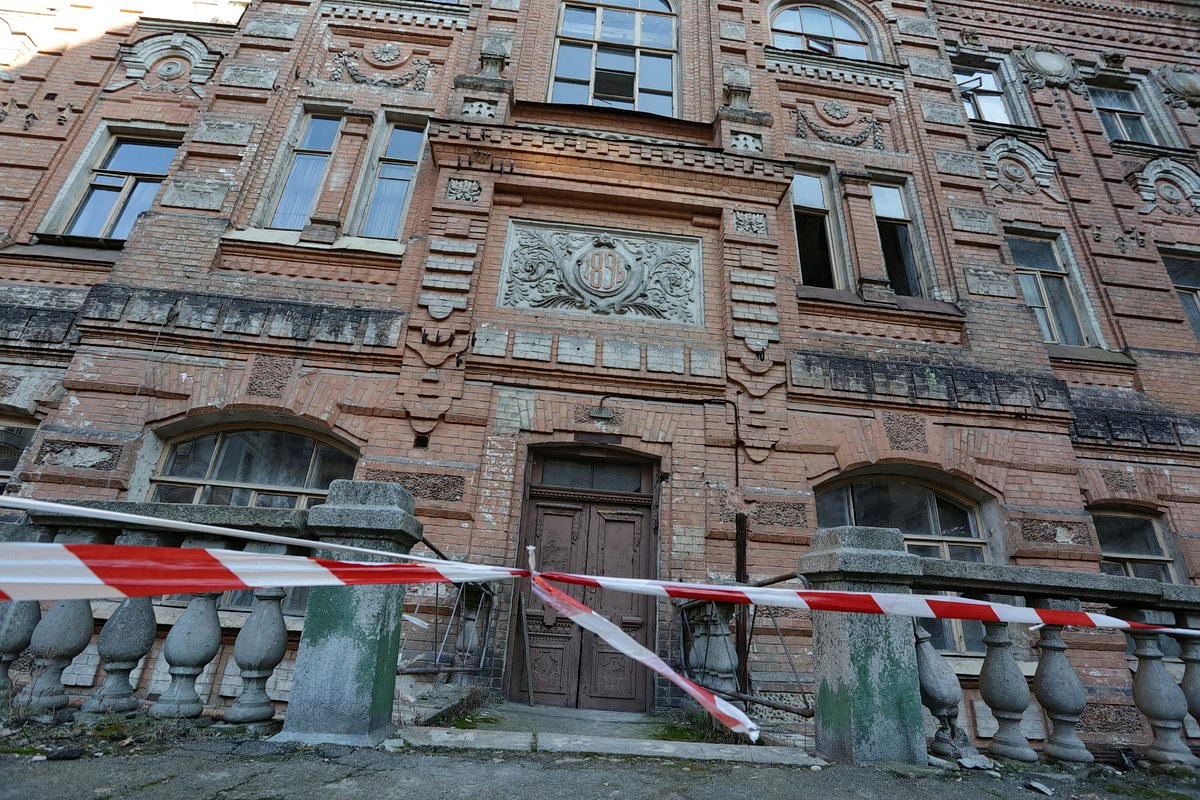Kyiv’s historical center is dotted with crumbling, abandoned buildings of architectural and historical importance, many of which are now in a perilous state.
And it’s getting more and more difficult for city hall to ignore the problem: on Feb. 25 an old building just 200 meters away from the mayor’s office collapsed. Two construction workers were killed in the accident.
The collapsed residential building, at 12-14 Bogdan Khmelnytskiy Street, was built in 1884 and classified as an architectural monument. Its inhabitants were relocated in 1984. In 2004 the building was handed over to an investor for reconstruction, but it remained empty and decaying.
Rescuers enter a house on Bohdan Khmelnytsky Street in Kyiv on Feb. 25. Сeilings from the fifth to the first floor of the house collapsed during reconstruction works. Photo by Anastasia Vlasova.
There are dozens of other such buildings in the center of the capital: According to an inspection of all of Kyiv’s housing stock launched by the capital’s mayor, Vitali Klitschko, 48 of Kyiv’s old residential buildings are in critical condition, 101 buildings are uninhabitable and 150 are in unsatisfactory condition.
Some 40 percent of those buildings are in private ownership. On March 9, Klitschko ordered the city’s district authorities to force the owners of such buildings to clean them up and take accident-prevention measures. The mayor also promised to raise the question of returning these buildings to city ownership, and then selling them off again at an auction.
Homes for crows
Four such buildings stand in Kyiv’s historic center, at 33, 35, 35b and 37b Pushkinska Street. Built by the late 19th and early 20th century millionaire Kyiv industrialist Fredrich Michelson in 1896, the buildings — fine examples of late 19th century Kyiv architecture – have been abandoned since 1998, and are now home only to crows.
Friedrich Michelson owned several houses in Kyiv but the ones on Pushkinska Street were built as his personal residence. Photo by Anastasia Vlasova
In Soviet times, the buildings had housed families sharing communal apartments. But the residents moved out under the city’s program for relocating the inhabitants of old buildings in the historic downtown to new apartment blocks further from the center.
As the city did not have the money to repair the historic old buildings, it sold them to an investor company called D.I.B. The houses were then re-sold twice, and ended up in 2010 in the hands of a company called House on Pushkinska.
Over the 18 years since they were abandoned, no repair work has been done on the buildings. Now their façades are crumbling, the glass from most of their windows is broken or missing, and there are holes in their roofs.
“We’re not doing anything because the real estate is contested in the courts, and all attention is going there instead of doing the restoration,” said Viktoria Yakovleva, information policy advisor at NEST, a development company that plans to redevelop the buildings. Yakovleva said NEST was working with House on Pushkinskaya in a joint project at the site, but that there was no other link between the two companies.
Viktoria Yakovleva shows the yard of the Michelso’s mansion on March 16. She insists the investor is willing to restore the buildings but cannot do this because of court battles with locals, city council deputies and prosecutors over the property. Opponents say the investor is irresponsibe and is waiting for the monuments to collapse. Photo by Anastasia Vlasova.
Indeed, Michelson’s buildings have been the subject of a court battle between the residents of the neighboring houses and the owner of the buildings since 2004.
According to Yakovleva, the estimated cost of the buildings’ restoration is $15 million. To make the project profitable, the developer plans to add an extra floor to the houses, build another apartment block on the site of a nearby ruined and abandoned kindergarten, and create a parking area under the historic buildings, which will also reinforce their foundations.
One of the most vehement opponents of the company in the courts is local resident Mykola Zhukov, a university professor and head of a civil activism group call the Resident Self-Organization Body. Zhukov told the Kyiv Post that NEST’s development plans would undermine neighboring houses, block their sunlight, and deprive local children of a kindergarten.
Zhukov claims the companies that bought the Michelson buildings in 1998 belong to developer NEST, and that the decaying houses should be taken back by the city from an irresponsible owner and re-sold to serious investors. NEST denies the connection, saying that it started working on the project only in 2010.
“Some people say that the owners of old homes deliberately wait for their properties to collapse in order to demolish them and build something new instead,” Yakovleva said. “But a new building would be less attractive and would not be as valuable as a historic building.”
No coordination
There are 1,500 registered buildings of architectural value in Kyiv, according to Andriy Pechinkin, the deputy director of the state control inspection of cultural heritage and archaeological oversight in the Kyiv City Culture Department.
But when the Kyiv Post asked Pechinkin how many of these buildings are abandoned or in a perilous state, he would only say his department was “compiling this information.”
And while the Law on Cultural Heritage holds the owners of historical building responsible for their upkeep, there is no single register of their owners. As a result, “it’s quite difficult to trace ownership when buildings owned by private individuals are returned to communal or state ownership, or vice versa,” Pechinkin said.
That’s partly due to a lack of coordination between the local and state authorities.
“In this case, we need to cooperate with the department of communal ownership, but they don’t tell us who they sell historic buildings to,” Pechinkin told the Kyiv Post. “Then we also have state owned assets managed by the State Property Fund, which also doesn’t inform us (about sales).”
And there are only four inspectors supervising all of Kyiv’s historic buildings, according to Pechinkin.
Civil activists gave the Kyiv Post better information about the number and state of abandoned historic residential buildings in Kyiv. There are over 30 objects on their red list of historic buildings under threat of collapse, said Bohdan Kozhushko, the deputy head of the Ukrainian Society for the Protection of Monuments of History and Culture.
“Most are in private ownership,” Kozhushko said. “Each of them has an owner who is very difficult to find until some incident happens with the object.”
Kozhushko believes those who obtain ownership of historical buildings in Kyiv have good reason for wanting to stay off the radar.
Opportunities for new construction downtown are limited, as there are no free land plots in central Kyiv, and the land under abandoned historical buildings is often of more value than the buildings themselves, Kozhushko said. Moreover restoring such buildings costs seven or eight times more than constructing a new building, he said.
“If a building is not restored for many years, it becomes clear that it was obtained in order just to be re-sold or slowly brought to collapse,” Kozhushko told Kyiv Post.
Preventative measures
Pechinkin, from the state control inspection of cultural heritage, said the authorities can still prevent more of these buildings collapsing. To do so, the authorities need to find their owners, buy them out, or find breaches in the sales contract that render the sale void.
“This scheme (of privatizing historic buildings and waiting for them to collapse) is very old, but it’s not working, because earlier people knew how to build for centuries and millennia,” Pechinkin said.
However, there is no guarantee that after the buildings are taken out of private hands that the city will be able to renovate them. For example, the mansion of the famous turn-of-the-century Ukrainian painter Oleksandr Murashko at 14-A Mala Zhytomyrska Street was returned to the city from irresponsible owners in 2011. Since then, all of the documentation has been prepared for its conservation, but the city council has not yet allotted funds for it.
Some experts believe higher property taxes could force irresponsible private owners either to sell empty historical buildings, or start investing in them. However, Pechinkin says the opposite — investors need to be exempted from taxes in exchange for them developing investment programs that allow such buildings to be used again, while retaining the characteristics that make them objects of cultural heritage.
“For instance in Poland, historical buildings can function as food outlets, hotels or anything else — but without extensions or reconstructions,” Pechinkin said.
Kyiv Post staff writer Olena Savchuk can be reached at [email protected]



